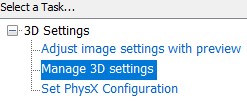New
#1
NVidia introduces Max Frame Rate setting marking an end to V & G Sync
So basically for a decade now people were given riddles about why their high end rigs are "Tearing" (Lite or heavy stuttering on monitors on movement or sometimes standing still) .
The offered solution was always to direct them to activate what is called V-Sync option for those with monitors with refresh rates of 60 Hz and G-Sync option for those with 120+ Hz monitors .
It was slowly belt that apparently recent GPUs come now more powerful than monitors' capabilities (Back in the 2k era if we could render a game at 30 fps (Frames Per Second) we would feel blessed that our eyes wont strain any more but now we take games to the edge by selecting ultra graphics settings profile and yet a modern GPU like an NVidia 2070+ may well render it still at close to 200 fps) .
A rule of thumb was established , 60 Hz monitors (Almost all laptops' monitors and the majority of the HD/FHD monitors in circulation) were capable of displaying up to 60 fps , if more frames were given it would start to tear , on the other hand 120+ Hz monitors were capable of displaying equivalent number of frames to Hz capability of the monitor (i.e 120 fps on 120 Hz monitors , 144 fps on 144 Hz monitors and so forth) and tearing would still happen if given more fps .
Now to remedy that tearing effect technologies like V-Sync & G-Sync were introduced where people (even techs) knew little about how they work or were given odd theoretical explanations about what they do , but basically what these cuties officially did was discarding the extra fps above what the monitor can handle .
Now if you come to think of it this had never been the optimum solution , basically because the GPU was working harder than needed consuming power and producing heat and shortening its life span .
Now finally with the introduction of "Max Frame Rate" starting driver version 441.87 you can put an end to all these blahs . With the GPU working at core to produce frames to the ceiling of your display , no more tearing , no more extra power , no more heat , longer life , optimization baby .
So setting it up is pretty simple :
1 - Identify your screen Hz *
2 - Right click your Desktop then choose "NVIDIA Control Panel"
3 - On left panel choose "3D Settings" then "Manage 3D Settings"
4 - On the right side head to "Global Settings" then scroll till you find "Max Frame Rate"
5 - Set its value to 2 frames less than your Hz value **
6 - Apply and you are done for good !
#GPU_Optimization
Cheers
P.S This thing is brand new , so I am expecting some glitching for some so be ready to re-activate Sync back if it doesn't work its wonders for you until the option is solid .
* Right click your Desktop and select "Display Settings" then "Display" then "Advanced display settings" then "Display Adapter Properties For Display 1" , from window that opens select the "Monitor" tab then click on the dropdown box called "Screen Refresh Rate" (Largest value of Hertz you see will be your monitor's maximum Hz capability) .
** The 2 frames less is a recommendation by NVidia probably a safety margin for glitching
Last edited by nIGHTmAYOR; 10 Jan 2020 at 10:45.







 Quote
Quote
